As we continue to get through the colder, darker and more sedative months of winter, 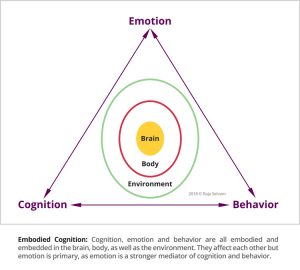 inversions and backbends are a fantastic and holistic way to combat the symptoms of SAD (seasonal affective disorder), exhale out the stress of the holidays and warm up the body and soul. Due to their physical form backbends and inversions activate the vagus nerve. The vagus nerve has a direct effect on our levels of energy and mood. In modern psychology the concept of embodied congnition is used to discuss this body to brain connection. This theory that the body can affect the brain is a concept that Hatha Yoga has always asserted. It affirms that if we transform the more gross, or physical aspects of life, for example physical posture or breath rhythm, we will be able to change the more sutil parts of our existence such as thoughts and perspectives. This ability to change our thoughts and perceptions is fundamental to our wellbeing.
inversions and backbends are a fantastic and holistic way to combat the symptoms of SAD (seasonal affective disorder), exhale out the stress of the holidays and warm up the body and soul. Due to their physical form backbends and inversions activate the vagus nerve. The vagus nerve has a direct effect on our levels of energy and mood. In modern psychology the concept of embodied congnition is used to discuss this body to brain connection. This theory that the body can affect the brain is a concept that Hatha Yoga has always asserted. It affirms that if we transform the more gross, or physical aspects of life, for example physical posture or breath rhythm, we will be able to change the more sutil parts of our existence such as thoughts and perspectives. This ability to change our thoughts and perceptions is fundamental to our wellbeing.
One of the principal mechanisms of this transformation in thought and perception is found in the vagus nerve. All Yoga poses work with the nervous system, but thanks to their physical forms, inversions and backbends are especially effective for activating the vagus nerve, increase levels of energy and transform a negative perspective into a positive outlook.
What is the Vagus Nerve?
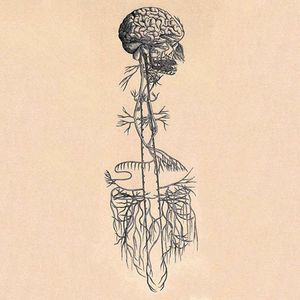 The Vagus Nerve is a fascinating nerve that is linked to everything from digestion to depression. Vagus is Latin for ´to wander´ and that is exactly what this nerve does. Looking kind of like an upside tree, it starts up behind the ear moves down the neck and continues to spread out it´s tentacles along the chest, around the heart and into the gut. 70-80% (some research says 90%) of the information that is passed along the vagus nerve moves from the bottom up and only 20-30% of it moves from the top down. This is why some people say the second brain is in the gut. All those sensations that are experienced in the gut (which has as many neurons as a cat´s brain) and along the organs connected to the Vagus Nerve are sent up to the brain to be analyzed and interpreted by the pre-frontal cortex, language centers and amygdala. That means working with the vagus nerve and the organs connected to it can modify messages sent to the brain about sensations that are experienced in the body.
The Vagus Nerve is a fascinating nerve that is linked to everything from digestion to depression. Vagus is Latin for ´to wander´ and that is exactly what this nerve does. Looking kind of like an upside tree, it starts up behind the ear moves down the neck and continues to spread out it´s tentacles along the chest, around the heart and into the gut. 70-80% (some research says 90%) of the information that is passed along the vagus nerve moves from the bottom up and only 20-30% of it moves from the top down. This is why some people say the second brain is in the gut. All those sensations that are experienced in the gut (which has as many neurons as a cat´s brain) and along the organs connected to the Vagus Nerve are sent up to the brain to be analyzed and interpreted by the pre-frontal cortex, language centers and amygdala. That means working with the vagus nerve and the organs connected to it can modify messages sent to the brain about sensations that are experienced in the body.
Furthermore, the majority (80-90%) of the ´feel good´ neurotransmitter, serotonin is produced in the gastro-intestinal tract. The upward movement of information along the Vagus Nerve and the connected internal organs demonstrates how working with the body, one gets to the brain. Changing body forms influences our energy levels, hormones, sexual desire, sleep patterns and digestion by toning the vagus nerve. Working with the body to control the mind and increase quality of life IS precisely the theory behind the practices and postures of Hatha Yoga.
Psychology and the Vagus Nerve
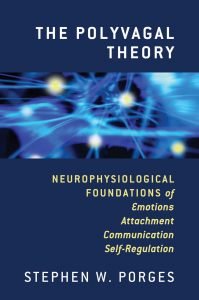 According to the polyvagal theory presented by Dr. Stephen Porges, director of the Brain and Body Center at the University of Illinois, as well as other related theories presented by researchers such as Dr. Levine, founder of Somatic Experience, and Dr. Van Der Kolk, it is hypothesized that there is a direct connection with the poor functioning of the vagus nerve and its associated organs with anxiety and depression. Simply put, the hypothesis is that anxiety has it´s root in an overactive fight/flight response and depression is then the result of the frustrated fight/flight response. In other words, when the nervous system perceives that there is no way out of a perceived threat, the biological defense response is a kind system shut-down that results in what researchers call ´freeze´ and what would be experienced on the emotional level as depression.
According to the polyvagal theory presented by Dr. Stephen Porges, director of the Brain and Body Center at the University of Illinois, as well as other related theories presented by researchers such as Dr. Levine, founder of Somatic Experience, and Dr. Van Der Kolk, it is hypothesized that there is a direct connection with the poor functioning of the vagus nerve and its associated organs with anxiety and depression. Simply put, the hypothesis is that anxiety has it´s root in an overactive fight/flight response and depression is then the result of the frustrated fight/flight response. In other words, when the nervous system perceives that there is no way out of a perceived threat, the biological defense response is a kind system shut-down that results in what researchers call ´freeze´ and what would be experienced on the emotional level as depression.
In fact, when we enter in this this freeze response, the part of the brain that controls language also shuts down. It is for this reason that Dr. Van Der Kolk in his research with soldiers suffering from PTSD (Post Traumatic Stress Disorder) observed that therapeutic body work was more effective than traditional talk therapy or prescription pharmaceuticals. He realized that one has to enter into the body to release the tension physically held in the body; something that talking and pills just do not do.
Researchers like Levine, Porges and Van Der Kolk argue that often sensations of stress, anxiety and depression occur first in the body and are then interpreted in the brain. The primary path of this communication from body to brain is the vagus nerve. There is more and more literature discussing the importance of a good ´vagal tone´ to maintain both mental and physical health. In fact, pharmaceutical giants Glaxo-Smith-Kline are trying to make profit out of this fact by investing over 50 million dollars in researching a device that would provide vagus nerve stimulation (Medicine Beyond, p. 235). Lucky for humanity, Vagus nerve stimulation is something that Hatha Yoga has been providing naturally and free for over thousands of years. A well executed Yoga asana will activate and relax the nervous system, the fascia, multiple meridians, the endocrine system, muscles, bones, joints, tendons and ligaments all at once. It is for this reason that Hatha Yoga is a such a timeless and powerful practice.
Backbends/Back extensions:
Due to the physical form of these poses backbends work directly with the vagus nerve. Backbends, or back extensions as they are also known, work by opening and toning the front of the belly, chest, sternum and throat which, as mentioned earlier is home to that wandering vagus nerve.
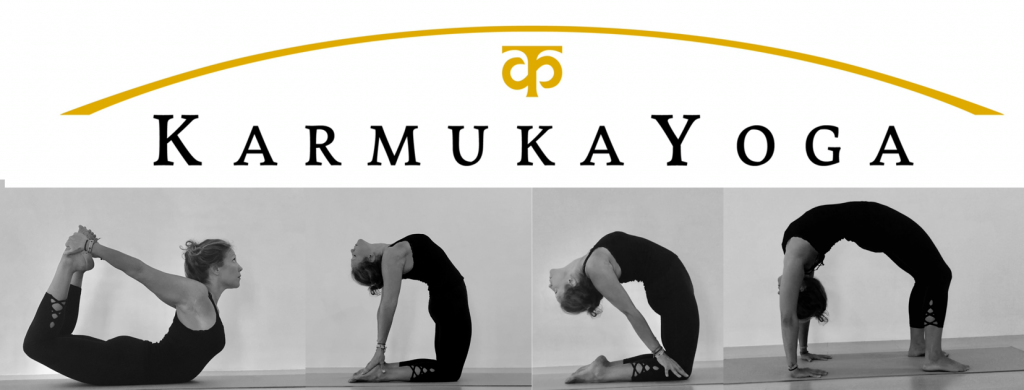
Via breath, pressure, stretching and by holding back bends SAFELY while breathing into the pose the organs associated with the vagus nerve and the nerve itself is activated, toned and strengthened. A well ´toned´ vagus nerve and the attached organs means that the brain receives biological signals of relaxation such as a regulated digestive tract, slower heart rate and deeper breath. It signals to the brain, via the Vagus Nerve, that all is well, there is no lion nearby (literally or figuratively) and there is no need prepare for a fight or running way.
Backbends/Back extensions Precautions:
It is important that when practicing backbends that one take great care around the lumbar spine. The most common mistake in these poses is to clench the buttocks and collapse into the pelvis rather than extending out of it-which can result in compressing the lumbar spine. For example, when going up into poses like bridge (urdva danurasa), compression of the lumbar occurs when one pushes straight up through the public bone or belly button rather than lengthening the lumbar away from the ribs and ribs away from the pelvis and sacrum. My advice in all back bends is, to think about internal rotation of the thigh bone to active the abductors…the muscles on the inside of the thighs. This action will automatically open the space around the lumbar and create a sense of emptiness through the belly. Always start slow and gain real awareness of what the space around the lumbar, stretch across the chest and strength in the arms and legs FEELS like. Look for the correct sensation, not just the correct formation. You can read more about the lumbar spine and pelvic connection here.
Inversions:
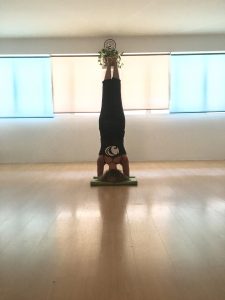
For thousands of years human beings have practiced inversions and now in various physical therapy clinics, props like inversion tables are common.
The mechanics of inversions are fantastic not only for decompressing the entire spine, but are also great for increasing lung capacity, activating digestive organs, strengthening the immune system (by helping to activate the lymphatic system), regulating hormone release and increasing the production of all those feel good neurotransmitters like dopamine and serotonin. All this neuro-biological activity that occurs during inversions results an overall more balanced state of emotional, mental and physical well-being. It is for this reason Sirsasana (Headstand) is often referred to as the King of Asanas and Sarvangasana as the Queen of Asanas.
Inversion Precautions
The most common mistake in inversions is putting too much pressure on the neck and not bringing the weight of the body into the shoulder girdle. Again, look for the 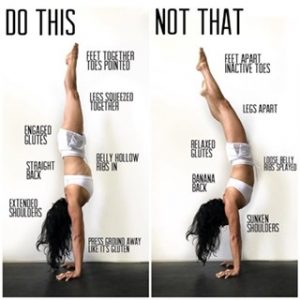 correct sensation, not just the correction formation. One should feel activation in the triceps, the dorsal spine and the pectorals NOT the neck or lumbar spine. For example, in Sirsasana, think about pushing the shoulder blades up towards the hips, lengthen floating ribs to the pelvis and anterior ribs to the armpits. Press firmly the elbows and wrists towards the ground and maintain the aforementioned rotation of the thighs, like you would in a back extension, to find that same sense of hollowness and space around the belly and lower spine, as experienced in backbends. You can read more about the neck, shoulder and skull connection here.
correct sensation, not just the correction formation. One should feel activation in the triceps, the dorsal spine and the pectorals NOT the neck or lumbar spine. For example, in Sirsasana, think about pushing the shoulder blades up towards the hips, lengthen floating ribs to the pelvis and anterior ribs to the armpits. Press firmly the elbows and wrists towards the ground and maintain the aforementioned rotation of the thighs, like you would in a back extension, to find that same sense of hollowness and space around the belly and lower spine, as experienced in backbends. You can read more about the neck, shoulder and skull connection here.
Karmuka Yoga and Yamuna Body Rolling
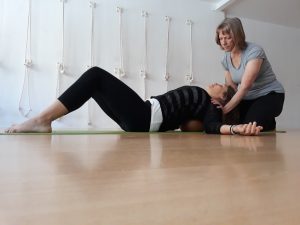
In the Karmuka Yoga workshops I have observed how the work of Yamuna Body Rolling is very effective in helping students to become aware of correct and safe internal action as well as creating space and movement in blocked areas of the body, thereby making the postures of Hatha Yoga, espeically backbends and inversions, more accessible.
For example, I have a wonderful student who is 70 years old and during all of her life she has been very active and has had a constant and disciplined Yoga practice. Nonetheless, she was never able to lift her legs without help when entering into Sirsasana (Headstand). In the Inversions and Backbends workshop 2019, after freeing of the ilias psoas and the ribcage with the work of Yamuna Body Rolling, she screamed with great surprise as she lifted her legs up with ease into Sirsasana without any help at all. You can read her comments here.
I have another student who had practiced Yoga for years with other teachers and she always suffered from lumbar pain when practicing backbends. Observing her practice, I offered a small correction in the rotation of her legs and heel connection. Suddenly she was able to enjoy Urdhva Dhanurasana without any type of pain in her lower spine.
—————
In Karmuka Yoga we know that there is ALWAYS a way to modify and practice a Yoga pose so that you do not hurt yourself – even ONLINE!! We aim to help you become aware of the internal actions that enable you to enjoy all the great benefits of these powerful asanas.
If you would like to learn more and feel for yourself how you can safely execute these poses without causing harm to yourself or others and experience all the feel good effects highlighted above, than you won´t want to hesitate to sign up for the Yoga Back Bends Master Class in the Presente Yoga Center in San Luis Potosí, December 9th from 5pm to 7pm.
